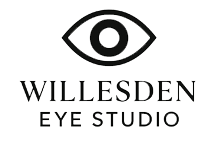Advanced Comprehensive Eye Examination
At Willesden Eye Studio, we allocate 40 minute tests which are twice as long as the UK standard to ensure you receive precise vision and optimal management of your eye health. Our team of experienced Optometrists offer comprehensive eye health examinations using the latest 3D OCT (Optical Coherence Tomography) scanning technology. This cutting-edge tool allows us to examine the internal structures of your eyes with incredible precision, helping to detect conditions like diabetic retinopathy, glaucoma and macular degeneration several years before symptoms appear.

Unlike standard eye exams, which provide only surface level insight, our OCT scan captures 1000 high-resolution cross-sectional images of your retina, optic nerve and surrounding structures. These images are then combined to create a detailed 3D model, giving us a clear view of all the layers of the retina.


This technology is quick, painless and non-invasive, meaning there’s no discomfort or need for direct contact with your eye. It enables us to monitor your eye health over time and detect early changes that might otherwise go unnoticed, ensuring you receive the best possible care and early intervention if needed.
Your eye test explained.
During the test, one of our optometrist will guide you through each step, ensuring you understand the process. At the end of the eye exam you’ll receive a clear and concise explanation of your eye health and recommendations regarding your glasses prescription.
Our eye examinations typically include the following steps:
Step 1 – History Review
Step 2 – Eye health screening
Step 3 – Vision Test
Step 4 – Personalised Recommendations
History Review
The optometrist will start by asking you questions about your general health, family history, lifestyle and symptoms you may be experiencing.

Eye health screening
This step involves assessing the overall ocular health by using advanced diagnostic tools. This may include the following checks depending on your age and individual needs:
- Autorefractor: This device requires you to look at a distant image which then takes an estimate of your prescription.
- Non-contact Tonometer: Here you will feel a small puff of air into your eyes which gives us your eye pressure readings.
- Digital retinal photography and OCT scans: This takes photos and scans of your eyes so we can assess the ocular health.
- Visual fields test: This is used to check your peripheral vision and most commonly used for patients with a family history of glaucoma.
- Slit lamp: This device uses magnification and light to view the external and internal eye structures.
- Cover test: Here we will check to see if your eye muscles are working together well.
Vision Test
Here you will be asked to read letters from an electronic chart to test your vision. Lenses will be used to demonstrate any improvements to your vision and determine your glasses prescription.
Personal recommendation
The optometrist will discuss your results with you and provide advice on maintaining good eye health. They will inform you about any changes in your prescription and you will have the opportunity to ask questions.


